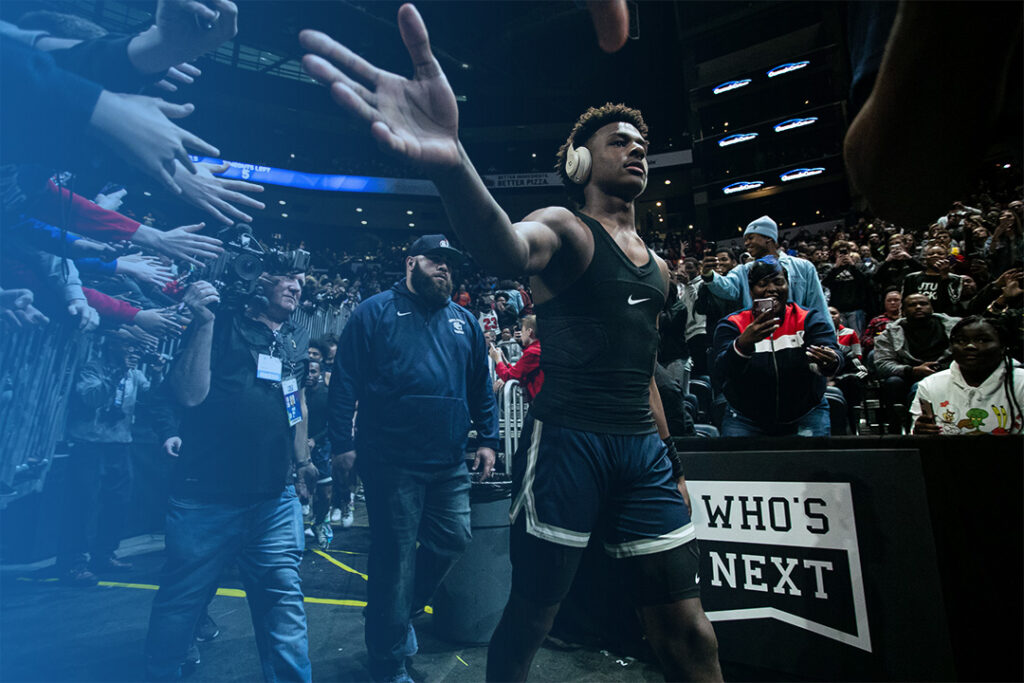The trailblazers of high school NIL

Less than a year after historic changes to name, image and likeness rights shook the core of college sports, high school athletes are following in the aftershock.
In March, The Atlantic reported that a five-star 2023 recruit signed one of the largest NIL deals to date with a collective that could pay him more than $8 million by his junior year in college. That same week, eight New York high school football players locked down the first-of-its-kind group endorsement deal with Performance Health.
The number of states allowing high school athletes to monetize their NIL is on the rise, but on the other end of the spectrum, many other states still prohibit it. This uncertainty is not easy to dive into, especially for the athletes jumping into the water first.
Just like the college athletes who spurred historic change in NIL rights (Ed O’Bannon and Shawne Alston) these high school trailblazers will cement their names in the sports history books for their contribution to the NIL movement.
Mikey Williams
A 17-year-old standout with stardom and opportunity, Mikey Williams is known across the sports community as a top college and NBA prospect and social media icon.
Less than a month after college athletes got the right to monetize their NIL, Williams made his mark in NIL history as the first high school athlete to sign with a major sports management firm, Excel Sports Management, and a few months later, lock down a national endorsement deal with PUMA. The 5-star recruit’s NIL worth is valued at $2.6 million, according to a sports market index developed by On3.
❤️💛✌🏽? pic.twitter.com/ZJ4UJP8Q5h
— Mikey Williams (@619PRESIDENTIAL) February 22, 2022
Williams has undoubtedly fought and earned his success, but his situation also stirs up conversations about the discrepancy in high school NIL legislation and opportunity. In 2020, Williams transferred from his hometown in San Diego to a private prep school in North Carolina to broaden his basketball opportunities. The private school does not fall under the same regulations as those of the North Carolina High School Athletic Association, which currently prohibits student-athletes from monetizing their NIL.
Only seven state high school associations explicitly allow athletes to pursue NIL right now, including Alaska, California, Kansas, Nebraska, New Jersey, New York, and Utah.
This imbalance has prompted state high school leaders to answer the question: What is best for their high school athletes, and is NIL part of the equation?
Quinn Ewers
It is tough to talk about high school NIL without mentioning Quinn Ewers, a five-star recruit from Texas who decided to forgo his senior season of high school football last August for a spot on Ohio State’s roster. Ewers had more than a million dollars in NIL offers on the table, but Texas law prohibited him from accepting them or he would lose his eligibility to play in his senior season.
While Ewers said financials were not the only factor impacting his decision, it was clear these restrictions were holding him back.
“Over the past few weeks, following Texas’ UIL informing me I would be prohibited from profiting off my own name, image and likeness, I’ve taken time to think about what lies ahead of me, both in the short- and long-term,” Ewers stated. “It’s unfortunate I’ve found myself in this situation, as my preference would have been to complete my senior season at Southlake Carroll.”
Ewers’ decision escalated the high school conversation forward, forcing leaders to have more discussions around high school NIL rights and how to keep their athletes from leaving their programs early.
Following Ewers’ first season with the Buckeyes, the redshirt freshman has transferred to the University of Texas (with his NIL deals still locked in) to fight for a starting spot on the field next season.
Jada Williams
Jada Williams is leading the way for female athletes across the board as they fight for their space in the NIL market.
The 17-year-old became the first female high school athlete to sign multiple national NIL deals out of the gate last year, just as NIL was taking off for college athletes. She has already inked partnerships with Spalding, Dicks Sporting Goods, and SLAM magazine.
This comes as no surprise for the California native whose talent speaks for itself. Williams led the way in helping the USA Women’s Under-16 National Team win the gold medal in the 2021 FIBA Americas U16 championship. She is also a top 20 recruit who has committed to UCLA.
Like the other players on this list, Williams built her success not only with her athletic abilities but through her prominence on social media where she has attracted more than 700,000 total followers.
Williams finds herself in a good spot in her early career with Women’s Basketball ranking second highest in NIL compensation, according to Opendorse, the leading technology provider in the athlete endorsement industry.
Her own success shows other girls and women, both in athletics and beyond, that hard work and dedication can knock down barriers to opportunity.
Bronny James
It is not the first time the son of basketball legend, Lebron James, has turned heads. Bronny James has long proven that he was slated to lead the way for his generation of athletes.
In February, James accepted his first NIL deal with PSD Underwear. While the details of the deal were not disclosed, his overall NIL value is slated above any other high school athlete at more than $5 million. James lives in California, a state that allows high school athletes to profit from NIL.
It is not the money that lands James on this list, but his proactive approach to protecting his brand and future. The junior prep star, who has a strong social media following of more than 10 million people across his platforms, has also filed three trademark applications with the intent of launching a brand of NFTs, clothing and video games, according to his lawyer.
High school athletes considering NIL can look at James as an example of how to strategically build a brand of value.
Malachi Coleman
A bundle of college offers to Malachi Coleman sit on his desk as he contemplates his bright future ahead. His talent on the football field is just as impressive as his drive to find opportunities off of it.
Coleman lives in Nebraska, a state that allows high school athletes to monetize their NIL. The four-star recruit does not have a large social media following compared to other athletes his age who are inking deals, but that has not slowed him down.
In February, Coleman secured an NIL deal with a restaurant in his hometown, Lincoln, Nebraska, becoming one of the first high school athletes in his state to achieve this.
Gonna make that little kid inside of me proud of how far we’ve come 🤞🏾 pic.twitter.com/iltgcuTd4L
— Malachi Coleman (@ChiColeman23) March 9, 2022
Coleman grew up battling the constant uncertainty and instability of the foster care system. He told his local news station, KOLN, he wanted to make a difference when found the chance.
When he eventually landed his NIL deal, he had no doubt in his mind where that money was going— to the same foster care system he grew up in.
“I know how some of those kids feel and how helpless they are,” Coleman told KOLN. “I want to be able to tell them and show them that no matter your circumstances you can make a difference.”
Coleman’s story helps paint a bigger picture in the high school community about what dedicated young athletes can do with support, determination, and opportunity.
What is next?
This list does not begin to scratch the surface of standout athletes, like Shareef O’Neal, Arch Manning and Hansel Emmanuel, that have changed the game and turned talent into opportunity. But there are still lengths to go in determining what the future of high school NIL should look like.
State and high school leaders across the country are leading thoughtful conversations. Parents, coaches and student-athletes are contributing their voices trying to figure out what is the best path forward.
Through all this uncertainty and change, one thing is clear: High school athletics is following closely behind its college neighbor into a new era of sports.


